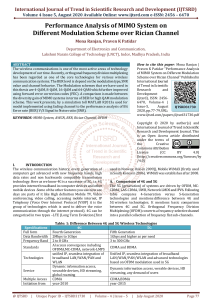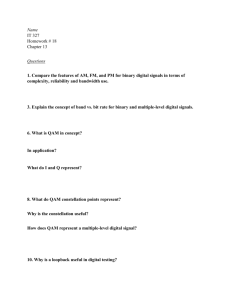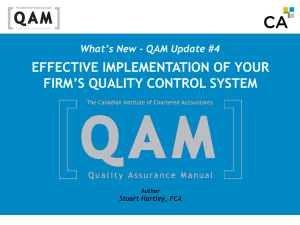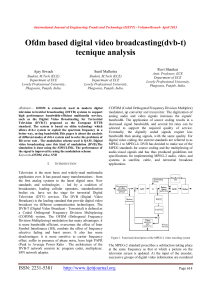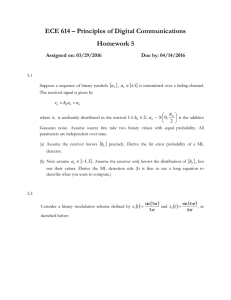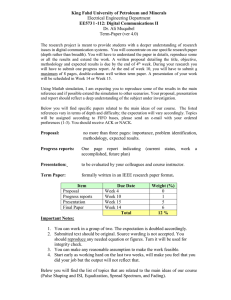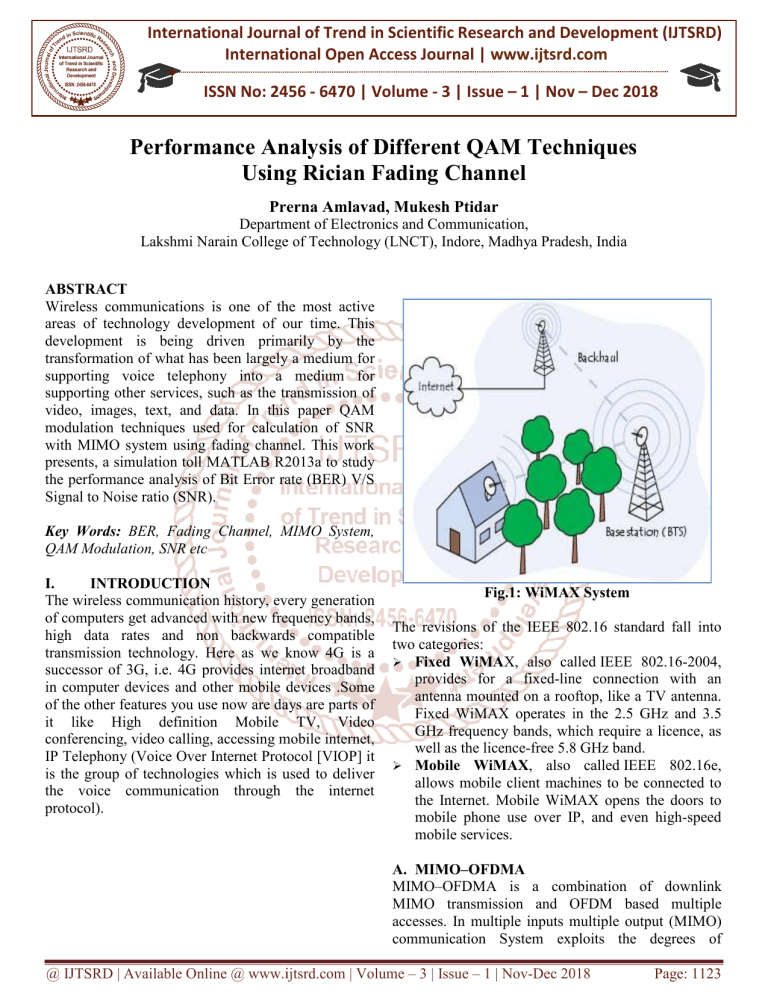
International Journal of Trend in Scientific Research and Development (IJTSRD) International Open Access Journal | www.ijtsrd.com ISSN No: 2456 - 6470 | Volume - 3 | Issue – 1 | Nov – Dec 2018 Performance Analysis of Different QAM Techniques Using Rician Fading Channel Prerna Amlavad, Mukesh Ptidar Department of Electronics and Communication Communication, Lakshmi Narain in College of Technology (LNCT), Indore, Madhya Pradesh, Pradesh India ABSTRACT Wireless ireless communications is one of the most active areas of technology development of our time. This development is being driven primarily by the transformation of what has been largely a medium for supporting voice telephony into a medium for supporting other er services, such as the transmission of video, images, text, and data. In this paper QAM modulation techniques used for calculation of SNR with MIMO system using fading channel. This work presents, a simulation toll MATLAB R2013a to study the performance analysis of Bit Error rate (BER) V/S Signal to Noise ratio (SNR). Key Words: BER, Fading Channel, MIMO System, QAM Modulation, SNR etc I. INTRODUCTION The wireless communication history, every generation of computers get advanced with new frequency bands, high data rates and non backwards compatible transmission technology. Here as we know 4G is a successor of 3G, i.e. 4G provides internet broadband in computer devices and other mobile devices .Some of the other features you use now are day days are parts of it like High definition Mobile TV, Video conferencing, video calling, accessing mobile internet, IP Telephony (Voice Over Internet Protocol [VIOP] it is the group of technologies which is used to deliver the voice communication through the iinternet protocol). Fig.1: 1: WiMAX System The revisions of the IEEE 802.16 standard fall into two categories: Fixed WiMAX,, also called IEEE 802.16-2004, provides for a fixed-line line connection with an antenna mounted on a rooftop, like a TV antenna. Fixed WiMAX operates in the 2.5 GHz and 3.5 GHz frequency bands, which require a licence, as well as the licence-free free 5.8 GHz band. Mobile WiMAX,, also called IEEE 802.16e, allows mobile client machines to be connected to the Internet. Mobile WiMAX opens the doors door to mobile phone use over IP, and even high-speed high mobile services. A. MIMO–OFDMA MIMO–OFDMA OFDMA is a combination of downlink MIMO transmission and OFDM based multiple accesses. In multiple inputs multiple output (MIMO) communication System exploits the degrees degree of @ IJTSRD | Available Online @ www.ijtsrd.com | Volume – 3 | Issue – 1 | Nov-Dec Dec 2018 Page: 1123 International Journal of Trend in Scientific Research and Development (IJTSRD) ISSN: 2456-6470 2456 freedom introduced through multiple transmitted and received antenna to offer high spectral efficiency. In narrow band channels, when channels state information is available at the transmitter and instantaneous adaptation is possible, the capacity attaining aining distribution is found by using the well wellknown water filling algorithm. B. 4-QAM The 4-state state Quadrature amplitude modulation (4(4 QAM) is a QAM with M=2 voltage levels or possible states for the signal. QAM transmits k bits of information during each symbol period, where k=log2M=2 bits, that is M=2k. In this condition the symbol rate is half of the bit rate, producing a spectrally efficient transmission. transmission The 16-state Quadrature amplitude modulation (16-QAM) (16 is a QAM with M=16 voltage levels or possible states for the signal, that is, four I value Q values. QAM transmits k bits of information ion during each symbol period, where k=log2M=4 bits, that is M=2k, consisting of two bits for I and two bits for Q. And the symbol rate is one fourth of the bit rate, producing a very spectrally efficient transmission. II. Fig. 2: MIMO-OFDMA OFDMA System Model BLOCK DIAGRAM OF SIMULATION MODEL The simulation system is shown in figure below, the system will be developed the MIMO-OFDM MIMO system using MATLAB. The adaptive modulation controller is receiving signal number of transmission and number of receiver and SNR, in control OFDM transmission and OFDM receiver signal. The graphs shown in simulation & result section of the paper clarify the process shown in the system model. Fig. 3: System Block Diagram SIMULATION RESULTS FOR DIFFERENT QAM SYSTEM WITH DIFFERENT CHANNEL In this paper work consider following input parameters are shown in table 1. The different III. modulation scheme are consider like (4-QAM, (4 16QAM and 64-QAM), with Rician Channel. The Carrier rate is ½ with FFT size 256 consider. The project work done by using simulation tool MATLAB R2013a Used. @ IJTSRD | Available Online @ www.ijtsrd.com | Volume – 3 | Issue – 1 | Nov-Dec Dec 2018 Page: 1124 International Journal of Trend in Scientific Research and Development (IJTSRD) ISSN: 2456-6470 2456 Table: 1 The Simulation parameter Parameters Value Communication Channel Fading Modulation Techniques 4-QAM, 8-QAM and 16-QAM QAM IFFT (Input port size) 256 CC Code Rate 1/2 Radio Technology OFDM Used Scheme Alamouti Model WiMAX 802.16e Calculation Parameters BER V/s SNR Simulation-Used Used Tool/Software Matlab (R2013a) Rician fading best describes a situation where a dominant non-fading, line-of-sight sight (LOS), component is present in addition to a number of indirect multipath signals. The fading envelope of this model is described by Rician probability density function (PDF). The performance of simulation results are fairly equals to theoretical results. The four color lines indicate the different QAM levels. The used communication channel Rician with QAM show in figure. 4. BER performance of QAM-OFDM over RICIAN channel 0 10 QAM-4 QAM-8 QAM-16 QAM-32 -1 BER 10 -2 10 -3 10 -4 10 -5 0 5 10 SNR 15 20 25 Fig: 4: BER performance of different QAM QAM-OFDM over RICIAN IV. RESULT ANALYSIS AND CONCLUSION In this performance, we have used the Alamouti scheme with communication Rician channel and different modulation techniques. The performance is displayed in figure 4 in terms of the BER verses SNR logarithmic plot. In the fig. 4 in this plot we analysis the 32-QAM, QAM, SNR is increased 4.1 dB on BER at 10 as compared to 16-QAM AM and Modulation Techniques. References: 1. Mehdi Ahmadi, EhsanRohani, Pooya Monshizadeh Naeeni and d Sied Mehdi Fakhraie, “Modeling and Performance Evaluation of IEEE 802.22 Physical Layer”. 2nd International Conference on Future Computer and Communication (ICFCC)-2010, (ICFCC) Wuhan, ISBN: 978-1-4244-5821-9, 9, 21-24 21 May 2010, Vol. 3 V3-62 - V3-66, 66, INSPEC Accession Number : 11538274 @ IJTSRD | Available Online @ www.ijtsrd.com | Volume – 3 | Issue – 1 | Nov-Dec Dec 2018 Page: 1125 International Journal of Trend in Scientific Research and Development (IJTSRD) ISSN: 2456-6470 2456 2. Y. Li, J. H. Winters and N. R. Sollenberger, “MIMO-OFDM for Wireless Communications Communications: Signal Detection with Enhanced Channel Estimation”, IEEE Transaction on Communications, Vol. 50, Issue 9, pp 1471 1471-1477, 2009. 3. S. Moghe and R. Upadhyay, “Comparison of SISO and MIMO Techniques in 802.11n Wireless Local Area Network”, International Conference on Emerging Trends in Electronic and Photonic Devices & Systems, pp 245-246, 246, 2009 4. T.P. surekha, T. Ananthapadmanab Ananthapadmanabha, C. Puttamadappa Members, IEEE, Modeling and Performance Analysis of QAM-OFDM OFDM System with AWGN Channel, ©2011 IEEE 5. Sai Krishna Borra; Suman Krishna Chaparala, performance evolution of OFDM system with Rayleigh, racian and AWGN channels, Volume 3, Issue 3, March 2013. 6. Ashutosh Kumar Mishra, Rashmi Pandey, A Review on Modeling and Performance of QAM QAMOFDM System with AWGN Channel, Volume 4, Issue 3, March 2014. 7. Kapil Narwal 1 , Yagvalkya Sharma 2, Performance Comparison of Turbo Codes with other Forward Error Correcting Codes, Jaipur National University, Jaipur, ISSN: 2277-1956. 2277 8. Y. Huang, B. Pei, and H. Zhang, “System Performance Research and Analysis of MIMO OFDM Based on Space-Time Space Block Codes”, International Conference on Intelligent Control and Information mation Processing, pp 414-417, 414 2010. 9. P. S. Mundra, T. L. Singal and R. Kapur, “The Choice of A Digital Modulation, Schemes in A Mobile Radio System”, IEEE Vehicular Technology Conference, Issue 5, pp 1-4,1993. 1 10. G. Ganesan and P. Stoica. 2001. “Space-time “Space block ock codes: a maximum SNR approach”, IEEE Transactions on Information Theory, Vol. 47, Issue 4, May 2001, pp. 1650–1656. 1650 11. A. Tarighat and A. H. Sayed, “MIMO OFDM receivers for systems with IQ imbalances,” IEEE Transactions on Signal Processing, Vol. 53, Issue Issu 9, pp. 3583–3596, 3596, September 2005. @ IJTSRD | Available Online @ www.ijtsrd.com | Volume – 3 | Issue – 1 | Nov-Dec Dec 2018 Page: 1126
